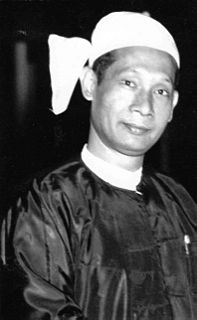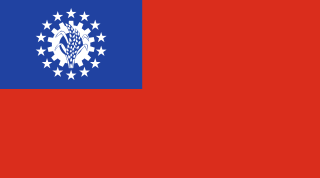| ||||||||||||||||||||||
| ||||||||||||||||||||||
202 (of the 250) seats in the Chamber of Deputies 126 seats needed for a majority | ||||||||||||||||||||||
|---|---|---|---|---|---|---|---|---|---|---|---|---|---|---|---|---|---|---|---|---|---|---|
| Turnout | 47.8% | |||||||||||||||||||||
| ||||||||||||||||||||||
| ||||||||||||||||||||||
 |
|---|
| This article is part of a series on the politics and government of Myanmar |
|
|
General elections were held in Burma to vote for 202 out of 250 seats to the Burmese Chamber of Deputies; the remaining 48 members (all from the Anti-Fascist People's Freedom League, AFPFL)) were elected unopposed as no opposition candidates stood against them. [1]

The Chamber of Deputies was the lower house of the bicameral Union Parliament of Burma (Myanmar) from 1948 to 1962. Under the 1947 Constitution, bills initiated and passed by the lower house, the Chamber of Deputies, were to be sent to the Chamber of Nationalities for review and revision.

The Anti-Fascist People's Freedom League, or hpa hsa pa la (ဖဆပလ) by its Burmese acronym, was the main political alliance in Burma from 1945 until 1958. It was founded by the Communist Party of Burma (CPB) led by Thakin Soe, the Burma National Army (BNA) led by Aung San, and the People's Revolutionary Party (PRP) at a meeting held between 1–3 March 1945 as a reorganised version of the Anti-Fascist Organisation (AFO), formed to resist the Japanese occupation. The new organisation aimed to resist the Japanese occupation and achieve independence.
Contents
The AFPFL, a former wartime resistance organisation, won the elections with a reduced majority. [2] After the election, U Nu, leader of the AFPFL, temporarily retired to reform the party and its policies. [3]

Nu, known honorifically as U Nu or Thakin Nu, was a leading Burmese statesman, politician, nationalist, and political figure of the 20th century. He was the first Prime Minister of Burma under the provisions of the 1947 Constitution of the Union of Burma, from 4 January 1948 to 12 June 1956, again from 28 February 1957 to 28 October 1958, and finally from 4 April 1960 to 2 March 1962.
The second part of the election to elect members to the Chamber of Nationalities took place on 22 May after the election commission stated that "rebel intimidation and the lack of security prevented the people from exercising freedom of choice". [1] Voter turnout was 47.8%. [4]
The Chamber of Nationalities was the upper house of the bicameral Union Parliament of Burma (Myanmar) from 1948 to 1962. Under the 1947 Constitution, bills initiated and passed by the lower house, the Chamber of Deputies, were to be sent to the Chamber of Nationalities for review and revision. The Chamber of Nationalities was primarily formed to give minorities within Burma some political power in the national government.
The Union Election Commission is the national level electoral commission of Myanmar (Burma), responsible for organising and overseeing elections in Burma, as well as vetting parliamentary candidates and political parties.







